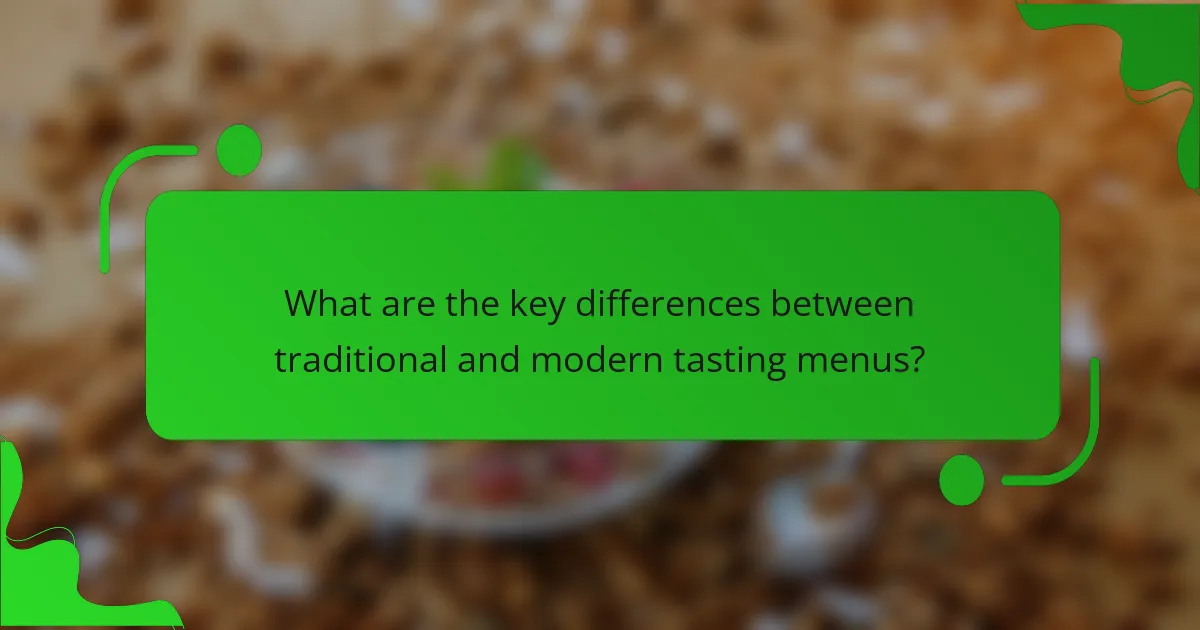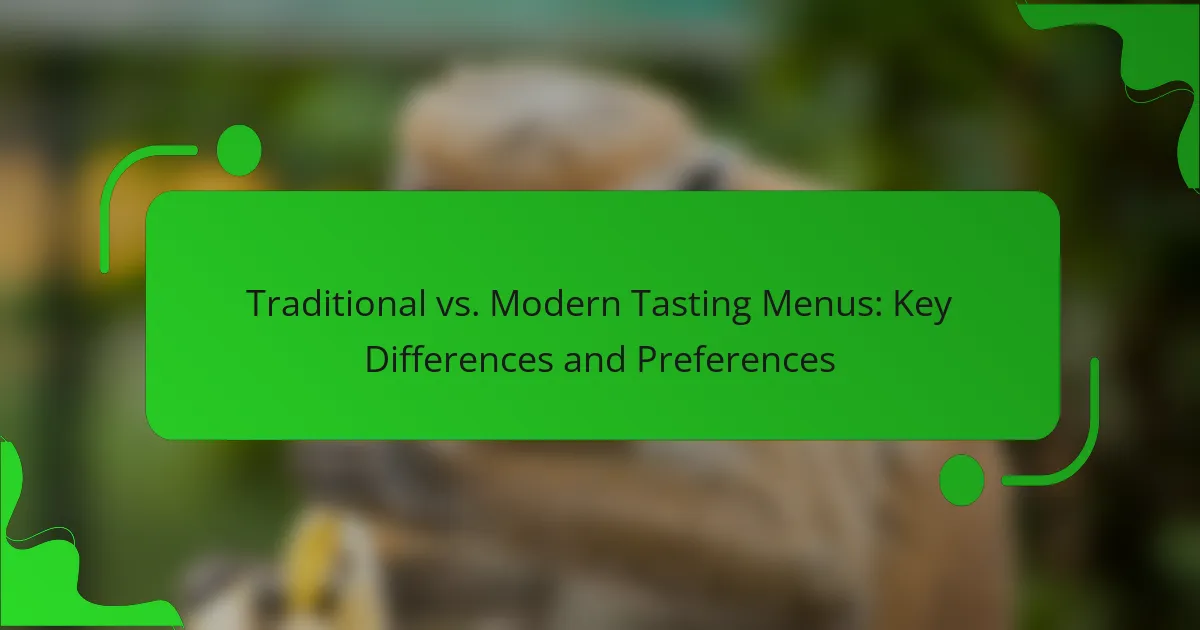When it comes to tasting menus, the distinction between traditional and modern styles is significant. Traditional tasting menus focus on classic techniques and familiar flavors, while modern menus embrace innovation and unexpected combinations. Understanding these differences can greatly enhance your dining experience and guide your choice based on personal preferences.

What are the key differences between traditional and modern tasting menus?
Traditional tasting menus typically emphasize classic culinary techniques and familiar flavor combinations, while modern tasting menus often incorporate innovative methods and unexpected pairings. Understanding these differences can enhance your dining experience and help you choose the right menu for your preferences.
Course structure variations
Traditional tasting menus usually consist of a fixed number of courses, often ranging from five to ten, with each course serving a distinct dish that follows a logical progression. In contrast, modern tasting menus may feature a more fluid structure, sometimes including smaller bites or interactive elements that encourage exploration and engagement with the food.
Some modern menus might even allow diners to customize their experience by selecting courses from a broader selection, providing a more personalized dining journey.
Ingredient sourcing approaches
Traditional tasting menus often rely on established, high-quality ingredients that are locally sourced and seasonally appropriate. Chefs may prioritize classic staples such as meats, seafood, and vegetables that have stood the test of time.
Modern tasting menus, however, frequently embrace a broader range of ingredients, including exotic or lesser-known items. Chefs may experiment with foraged ingredients, sustainable seafood, or unique spices to create innovative dishes that reflect contemporary culinary trends.
Presentation styles
In traditional tasting menus, presentation tends to be elegant and refined, focusing on the beauty of the dish while maintaining a sense of familiarity. Plates are often arranged with care, emphasizing the quality and craftsmanship of the food.
Modern tasting menus, on the other hand, may adopt avant-garde presentation techniques, using unconventional plating methods or incorporating elements like edible garnishes and artistic designs. This can create a visually striking experience that surprises and delights diners.
Flavor profiles
Traditional tasting menus typically feature well-established flavor profiles that highlight the natural tastes of the ingredients, often using classic sauces and seasonings. The emphasis is on balance and harmony, with dishes designed to complement one another.
Modern tasting menus often push the boundaries of flavor, incorporating bold, unexpected combinations and innovative techniques like molecular gastronomy. This can lead to unique taste experiences that challenge diners’ expectations and encourage them to explore new culinary landscapes.
Dining experience focus
Traditional tasting menus generally prioritize a formal dining experience, with a strong emphasis on service and etiquette. The atmosphere is often sophisticated, encouraging diners to savor each course in a leisurely manner.
In contrast, modern tasting menus may focus more on the overall experience, incorporating elements like storytelling, interactive dining, or even themed events. This approach aims to create a memorable experience that engages all the senses and fosters a connection between the diner and the food.

How do preferences vary in Los Angeles for tasting menus?
In Los Angeles, preferences for tasting menus reflect a blend of traditional and modern culinary experiences, with a noticeable inclination towards innovative, contemporary styles. Diners often seek unique flavor combinations and artistic presentations that modern menus provide, while still appreciating classic techniques and ingredients.
Popularity of modern tasting menus
Modern tasting menus have gained significant traction in Los Angeles, appealing to food enthusiasts eager for new culinary experiences. Many high-end restaurants now feature these menus, offering multi-course meals that highlight seasonal ingredients and creative pairings.
Restaurants like n/naka and Vespertine exemplify this trend, showcasing how modern tasting menus can transform dining into an immersive experience. Diners often rave about the artistry and storytelling behind each dish, making these menus a popular choice for special occasions.
Customer demographics
The demographic for modern tasting menus in Los Angeles tends to skew younger, with millennials and Gen Z diners leading the charge. These groups are often more adventurous and willing to explore new flavors and dining concepts, making them prime targets for restaurants offering innovative tasting experiences.
Additionally, affluent customers, regardless of age, are drawn to tasting menus as a way to indulge in high-quality cuisine and unique culinary artistry. This demographic is typically more open to spending on premium dining experiences, which further fuels the popularity of modern tasting menus.
Influence of local culinary trends
Los Angeles is known for its diverse culinary scene, which heavily influences tasting menu offerings. Trends such as plant-based dining, fusion cuisine, and sustainability play a significant role in shaping modern tasting menus, as chefs incorporate local produce and global flavors.
Restaurants often adapt their menus to reflect current trends, ensuring they remain relevant and appealing to the evolving tastes of their clientele. For example, many establishments now emphasize organic ingredients and innovative cooking techniques, aligning with the city’s health-conscious and environmentally aware dining culture.

What are the benefits of choosing a traditional tasting menu?
A traditional tasting menu offers a curated experience that highlights classic dishes and flavors, often reflecting regional culinary heritage. Diners can enjoy a well-structured meal that showcases the chef’s expertise in balancing taste and presentation.
Classic flavor combinations
Traditional tasting menus often feature classic flavor pairings that have stood the test of time. These combinations, such as duck with orange or lamb with rosemary, create a harmonious dining experience that appeals to a wide range of palates. By focusing on familiar tastes, these menus can evoke nostalgia and comfort.
When selecting a traditional tasting menu, look for dishes that emphasize seasonal ingredients and local produce, as these often enhance the classic flavors. For example, a menu might include a rich beef bourguignon paired with a robust red wine, showcasing both the dish and the beverage’s complementary qualities.
Established culinary techniques
Traditional tasting menus often rely on established culinary techniques that have been refined over generations. Techniques such as braising, poaching, and sous-vide cooking are commonly employed to enhance flavors and textures. These methods not only showcase the chef’s skills but also ensure that each dish is prepared to perfection.
When dining on a traditional tasting menu, expect to see dishes that highlight these techniques, such as a perfectly poached egg served with a delicate sauce or a slow-cooked roast that melts in your mouth. Understanding these methods can deepen your appreciation for the craftsmanship behind each course.
Cultural significance
Traditional tasting menus often reflect the cultural significance of the cuisine they represent. Each dish can tell a story, connecting diners to the history and traditions of a particular region. For instance, a menu featuring Italian cuisine may include risotto, which has roots in Northern Italy and showcases the importance of rice in that culture.
When choosing a traditional tasting menu, consider how the dishes represent local customs and celebrations. This connection to culture can enhance your dining experience, making it not just a meal but a journey through the culinary landscape of a region.

What are the advantages of modern tasting menus?
Modern tasting menus offer several advantages, including innovative ingredient use, creative presentation, and interactive dining experiences. These menus often emphasize seasonal and local produce, allowing chefs to showcase their culinary creativity while providing diners with a unique gastronomic journey.
Innovative ingredient use
Modern tasting menus frequently incorporate unconventional ingredients and techniques, pushing the boundaries of traditional cuisine. Chefs may experiment with molecular gastronomy, for example, using foams, gels, and sous-vide cooking to enhance flavors and textures. This approach not only surprises diners but also encourages them to explore new tastes and combinations.
When considering a modern tasting menu, look for dishes that highlight rare or underutilized ingredients, such as exotic mushrooms or unique spices. These elements can elevate the dining experience and make it memorable.
Creative presentation
Presentation is a key aspect of modern tasting menus, where dishes are often artfully arranged to create a visual feast. Chefs might use unusual serving vessels or incorporate edible garnishes that enhance the dish’s aesthetic appeal. This focus on artistry transforms each course into a multisensory experience.
To fully appreciate the creativity in presentation, take your time to observe each dish before tasting. The visual elements can provide context and enhance your understanding of the flavors and textures you are about to experience.
Interactive dining experiences
Many modern tasting menus include interactive elements that engage diners in the culinary process. This could involve tableside preparations, where chefs finish a dish in front of guests, or courses that require diners to assemble their own components. Such experiences foster a sense of participation and connection to the meal.
When choosing a restaurant with a modern tasting menu, consider those that offer these interactive experiences, as they can make your meal not just about eating but about enjoying the entire process of dining.

How do pricing models differ between traditional and modern tasting menus?
Pricing models for traditional and modern tasting menus vary significantly, reflecting different dining philosophies and experiences. Traditional tasting menus often have fixed prices based on a set number of courses, while modern tasting menus may offer more flexibility, including à la carte options or varying price tiers based on ingredient quality and presentation style.
Traditional Tasting Menu Pricing
Traditional tasting menus typically feature a fixed price for a multi-course meal, often ranging from moderate to high-end, depending on the restaurant’s reputation and location. Diners can expect a set number of courses, usually between five to ten, with each dish carefully curated to showcase seasonal ingredients and culinary techniques.
In many cases, the price of a traditional tasting menu includes wine pairings, which can add significantly to the overall cost. For instance, a traditional tasting menu in a fine dining establishment might start at around $100 and can exceed $300 per person, especially in major cities.
Modern Tasting Menu Pricing
Modern tasting menus often adopt a more flexible pricing structure, allowing diners to choose from various courses or create a customized experience. This can lead to a wider range of prices, with options that may start as low as $50 for a few courses and go up to several hundred dollars for an elaborate experience.
Some modern restaurants also offer tiered pricing based on ingredient quality, such as premium seafood or rare meats. This approach caters to diverse budgets and preferences, making high-end dining more accessible while still providing an exceptional culinary experience.
Considerations for Choosing Between Models
When deciding between traditional and modern tasting menus, consider your dining goals and budget. Traditional menus may provide a more structured experience, ideal for special occasions, while modern options can offer creativity and flexibility, allowing for a more personalized meal.
Additionally, think about the dining atmosphere and service style. Traditional tasting menus often emphasize formal service, while modern tasting menus may feature a more relaxed environment, enhancing the overall enjoyment of the meal.



